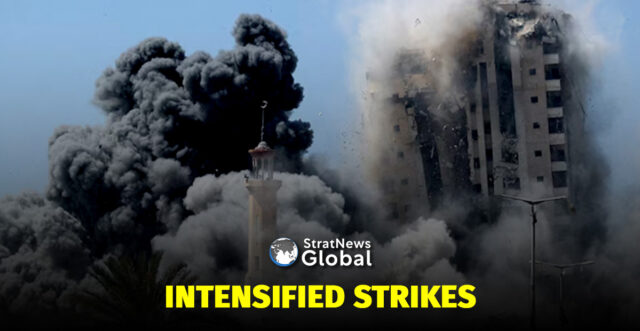After spending a decade paying off a $93,000 mortgage on his Gaza City apartment, Palestinian banker Shady Salama Al-Rayyes now finds his family destitute after an Israeli strike reduced the building to rubble.
The September 5 attack on the 15-storey Mushtaha Tower marked the start of an intensified Israeli military demolition campaign targeting high-rise buildings ahead of a ground assault towards the heart of the densely populated city, which started this week.
Over the past two weeks, Israel’s armed forces say they have demolished up to 20 Gaza City tower blocks they say are used by Hamas. Prime Minister Benjamin Netanyahu said 50 “terrorist towers” had been demolished.
Destructions And Displacements
The campaign has made hundreds of people homeless. In a similar time frame, Israeli forces have flattened areas in the city’s Zeitoun, Tuffah, Shejaia and Sheikh al-Radwan neighbourhoods, among others, ten residents told Reuters. The damage since August to scores of buildings in Sheikh al-Radwan is visible in satellite imagery reviewed by the news agency.
Al-Rayyes said he feared the destruction was aimed at permanently clearing the population from Gaza City, a view shared by the U.N. Human Rights Office (OHCHR). Its spokesperson, Thameen Al-Kheetan, said in a statement that such a deliberate effort to relocate the population would be tantamount to ethnic cleansing.
“I never thought I would leave Gaza City, but the explosions are non-stop,” Al-Rayyes said on Wednesday. “I can’t risk the safety of my children, so I am packing up and will leave for the south.”
Al-Rayyes vowed, however, never to leave Gaza entirely.
Israel’s finance minister, Bezalel Smotrich, said in May that most of Gaza would soon be “totally destroyed” and the population confined to a narrow strip of land near the border with Egypt.
Israel, which has called for all of Gaza City’s civilian residents to leave during the offensive, last week closed a crossing into northern Gaza, further limiting scarce food supplies.
In response to questions for this story, Israel’s military spokesperson, Lieutenant-Colonel Nadav Shoshani, said “there’s no strategy to flatten Gaza.” He said the military’s aim was to destroy Hamas and bring hostages home.
Tall buildings were used by Hamas to observe and attack Israeli forces, he said, adding that the Islamist militant group used civilians as human shields and also put booby-traps in buildings. Israeli soldiers are regularly killed by IEDs in Gaza.
Hamas has denied using residential towers to attack Israeli forces.
The goals of Israel’s military and its politicians are not always aligned, two Israeli security sources told Reuters, with one citing ideas such as clearing Palestinians from areas of Gaza for future redevelopment as diverging from military goals. Israel’s Prime Minister’s Office did not immediately respond to a request for comment.
The offensive is the latest phase in Israel’s war in Gaza, which has killed more than 65,000 Palestinians, spread famine and displaced most of the population, in many cases multiple times, since Hamas-led attacks in Israel on October 7 2023, killing 1,200 and taking 251 hostages. A total of 48 of the hostages remain in Gaza, and around 20 are thought to be alive.
Last week, a U.N. inquiry found Israel had committed genocide in Gaza. Israel called the finding biased and “scandalous.” U.N. experts say destruction of civilian housing and infrastructure can amount to a war crime.
Israeli spokesperson Shoshani said the buildings were legitimate military targets approved by an intelligence officer and a legal officer.
‘Panic, Fear’ After Evacuation Order
Before the war, Mushtaha Tower was popular with Gaza City’s professional class and students drawn to its ocean views and convenient location near a public park and two universities.
It originally housed about 50 families, but that number had tripled in recent months as people took in relatives displaced from other parts of Gaza, said Al-Rayyes.
Scores of tents housing more displaced families had spread around the tower’s base. The upper floors of the building had been damaged by previous strikes.
On the morning of September 5, a neighbour got a call from an Israeli army officer instructing him to spread the word to evacuate the building within minutes or they were “going to bring it down on our heads,” Al-Rayyes said.
Reuters could not independently verify his account of the evacuation order. It is consistent with accounts of residents of other buildings ahead of Israeli strikes. Shoshani said the military gave residents time to evacuate and ensured civilians had left before hitting the buildings.
“Panic, fear, confusion, loss, despair, and pain overwhelmed all of us. I saw people running on our bare feet; some didn’t even take their mobile phones or documents. I didn’t take passports or identity cards,” said Al-Rayyes, who had once hoped to pay off his mortgage by this year.
“We carried nothing with us, my wife and my two children, Adam, 9, and Shahd, 11, climbed down the stairs and ran away.”
Video filmed by Reuters shows what happened next. From the air, two projectiles exploded almost simultaneously into the base of the tower, demolishing it in around six seconds. Dust, smoke and debris billowed over the streets and tents of displaced people, who scattered, running and screaming.
In response to a question from Reuters, the Israeli military said Hamas had “underground infrastructure” beneath Mushtaha Tower that it used to attack Israeli troops. The military declined a request to provide evidence.
In a response to Reuters on Wednesday, the U.N.’s OHCHR said the Israeli military had also not provided evidence to demonstrate that other buildings described as terrorist infrastructure were valid military targets.
Al-Rayyes, who headed the building’s residents’ association, said the tactic of demolition “makes no sense,” even if there was a Hamas presence, which he denied.
“They could have dealt with it in a way that doesn’t even scratch people, not to destroy a 16-floor building,” he said, using a different count of its height.
After a couple of weeks with family in the city’s Sabra district, Al-Rayyes has left, like hundreds of thousands of other residents of the city since August, and was setting up a tent in central Gaza’s Deir Al-Balah on Thursday.
Military Demolishes Homes In Gaza City Outskirts
In preparation for the ground assault, in recent weeks, up to a dozen homes have been destroyed daily in Zeitoun, Tuffah, and Shejaia, the residents Reuters spoke to said.
Amjad Al-Shawa, head of the Palestinian Local NGOs Network, estimated that over 65% of buildings and homes in Gaza City had been destroyed or heavily damaged during the war. Extensive damage to suburban areas in recent weeks is visible in satellite images of several neighbourhoods.
The Conflict Location and Event Data (ACLED), a non-profit organisation that gathers data on conflicts around the world, documented over 170 demolition incidents carried out by Israel’s armed forces in Gaza City since early August, mainly through controlled explosions in eastern areas as well as Zeitoun and Sabra.
“The pace and extent of demolitions appear more extensive than in previous periods,” ACLED’s Senior Middle East analyst Ameneh Mehvar told Reuters. By comparison, she said fewer than 160 such demolitions were recorded in Gaza City during the first 15 months of the war.
The residents who spoke to Reuters also reported Israeli forces had blown up remotely driven vehicles laden with explosives in the Sheikh Radwan and Tel Al-Hawa neighbourhoods, destroying many houses in the past two weeks.
Shoshani, the military spokesperson, confirmed the use of ground-based explosives against buildings identified as military targets. He said he did not have information about explosive-laden vehicles specifically.
The U.N.’s OHCHR said it had documented controlled demolition of residential infrastructure, saying some entire neighbourhoods were destroyed.
Even before the current offensive on Gaza City, almost 80% of buildings in Gaza – roughly 247,195 structures – had been damaged or destroyed since the war started, according to the latest data from the United Nations Satellite Centre, gathered in July. This included 213 hospitals and 1,029 schools.
Bushra Khalidi, who leads policy on Gaza at Oxfam, said tower blocks were one of the last forms of shelter, and warned that pushing people out would “exponentially” worsen overcrowding in the south.
Tareq Abdel-Al, a 23-year-old student of finance from Sabra, was hesitant to leave his home with his extended family despite weeks of bombardment in the area, exhausted from being ordered to evacuate so many times in the war, he said. They left on the morning of August 19, only after houses neighbouring their 3-storey home were demolished.
Just 12 hours later, an Israeli strike destroyed the family home, he said.
“Should we have stayed, we might have been killed that night,” Abdel-Al told Reuters by phone from Nuseirat camp in central Gaza, describing extensive damage to the whole street.
“They destroyed our hope of returning,” he said.
(With inputs from Reuters)





